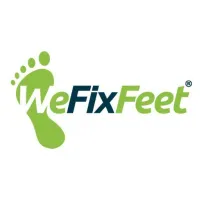
New Year, New You: Achieving Better Foot Health and Staying Injury-Free in 2025

New Year, New You: Achieving Better Foot Health and Staying Injury-Free in 2025
As 2024 comes to a close, it’s time to reflect on the past year and set our sights on the future. The start of a new year is the perfect opportunity to focus on your health and wellbeing, and that includes taking better care of your feet. Whether you're an avid runner, a weekend warrior, or simply looking to stay active, prioritising foot health is essential for staying injury-free and enjoying your favourite sports in 2025.
Why Foot Health Matters:
Our feet are the foundation of our bodies, supporting us in every step we take. Healthy feet are crucial for maintaining an active lifestyle and preventing injuries. Ignoring foot health can lead to a range of problems, from minor discomforts to severe injuries that can sideline you from your favourite activities.
Common Foot Injuries in Sports:
Active individuals are particularly prone to certain foot injuries. Here are some common issues you might encounter and how to prevent them:
Plantar Fasciitis:
This condition involves inflammation of the plantar fascia, a thick band of tissue running across the bottom of your foot. It’s often caused by overuse, improper footwear, or biomechanical issues. Symptoms include sharp heel pain, especially in the morning.
Achilles Tendinitis:
Inflammation of the Achilles tendon, often due to repetitive stress or sudden increases in physical activity. Symptoms include pain and stiffness along the back of the heel.
Stress Fractures:
Tiny cracks in the bones of the foot, usually resulting from overuse or repetitive force. Common in runners and athletes who engage in high-impact activities.
Ankle Sprains:
Stretching or tearing of the ligaments around the ankle, often caused by sudden twists or turns. Symptoms include pain, swelling, and difficulty walking.
Blisters and Calluses:
Friction from improper footwear or intense activity can lead to blisters and calluses, causing discomfort and increasing the risk of infection.
Looking Forward to 2025: Tips for Better Foot Health
Choose the Right Footwear:
Invest in high-quality shoes that provide adequate support and cushioning for your specific activities. Replace worn-out shoes regularly to ensure they continue to protect your feet.
Warm-Up and Stretch:
Before engaging in any physical activity, take time to warm up and stretch your feet and legs. This helps to increase blood flow, improve flexibility, and reduce the risk of injury.
Strengthen Your Feet:
Incorporate foot-strengthening exercises into your routine. Simple exercises like toe curls, arch lifts, and heel raises can enhance foot stability and prevent injuries.
Maintain a Healthy Weight:
Excess weight can put additional stress on your feet, leading to pain and injuries. Maintain a healthy weight through a balanced diet and regular exercise.
Listen to Your Body:
Pay attention to any signs of foot discomfort or pain. Early intervention can prevent minor issues from becoming major problems. Don’t push through pain; seek professional advice if needed.
Practice Good Hygiene:
Keep your feet clean and dry to prevent fungal infections and other foot problems. Change your socks regularly and use moisture-wicking materials to keep your feet dry during workouts.
Use Orthotics if Necessary:
Custom orthotics can provide additional support and correct biomechanical issues that contribute to foot pain and injuries. Consult with a podiatrist to determine if orthotics are right for you.
Stay Active Safely:
Gradually increase the intensity and duration of your activities to avoid overuse injuries. Cross-train to balance different muscle groups and reduce repetitive stress on your feet.
Treatment Options for Foot Injuries:
If you do experience foot pain or injuries, several treatments can help you recover and get back to your activities:
Biomechanical Assessment:
A thorough evaluation of your gait and foot mechanics can identify issues contributing to your pain. This assessment can guide the development of a personalised treatment plan.
Custom-Made Orthotics:
Orthotics are custom-designed shoe inserts that provide support and correct alignment issues. They can help alleviate pain and prevent further injuries.
Shockwave Therapy:
This non-invasive treatment uses sound waves to stimulate healing in damaged tissues. It’s effective for conditions like plantar fasciitis and Achilles tendinitis.
Class IV Laser Therapy:
Laser therapy reduces pain and inflammation while promoting tissue repair. It’s a valuable option for treating various foot and ankle conditions.
Sports Massage:
Regular sports massages can relieve muscle tension, improve circulation, and enhance recovery. They are particularly beneficial for athletes and active individuals.
Strengthening and Conditioning Exercises:
A tailored exercise program can improve foot strength and flexibility, reducing the risk of injuries. These exercises can be part of your regular fitness routine.
As we welcome 2025, make a resolution to prioritise your foot health. Whether you’re aiming to run a marathon, take up a new sport, or simply stay active, keeping your feet in top condition is essential. If you’re experiencing foot pain or want to prevent injuries, contact We Fix Feet for a comprehensive evaluation and personalised treatment plan. Book an appointment online or call us at 0115 9328832 to start the new year with healthy, injury-free feet.
Ask The We Fix Feet Team
Fill in the form to request a Call From Our Team
One of our team will call you for FREE and answer any questions or concerns you may have about your uncomfortable foot condition

Where To Find We Fix Feet
Our We Fix Feet podiatry clinics are conveniently located in Ilkeston, Derbyshire and Beeston, Nottinghamshire
Open: Mon-Fri 09:00-17:00 / Sat 09:00-13:00
94 Bath Street, Ilkeston, Derbyshire DE7 8FE
8 Wollaton Road, Beeston, Nottinghamshire NG9 2NR
Pay and display parking nearby




